What Is a Legacy System? Definition, Risks and What to Do Next
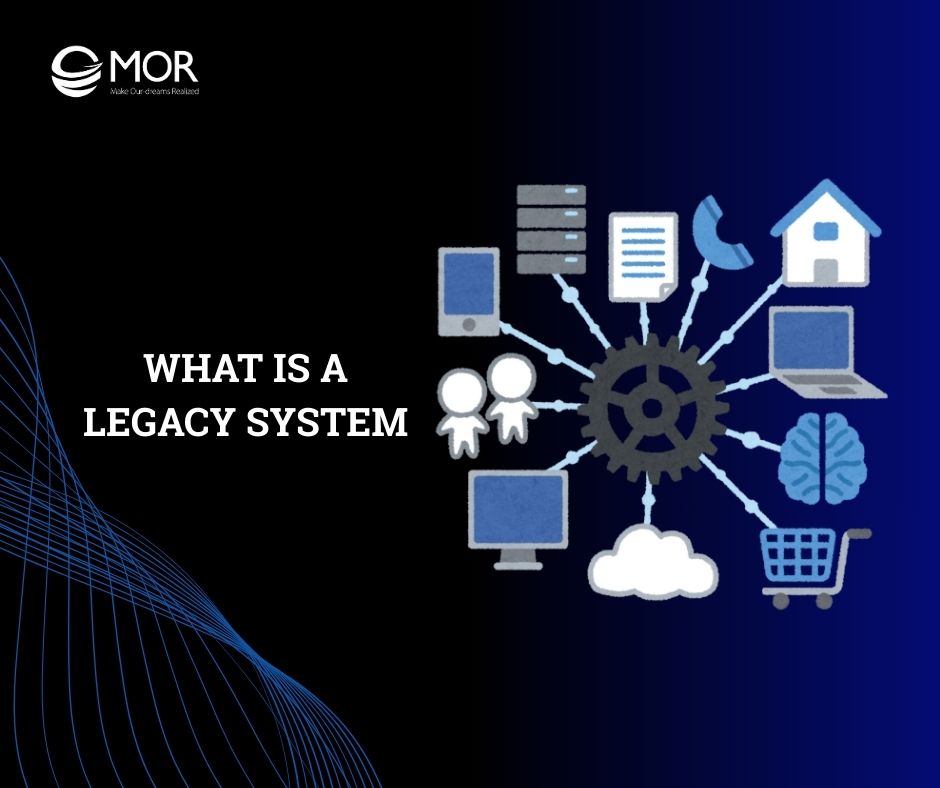
Many businesses still rely on systems built decades ago, so what happens when those tools start holding you back? If you’ve been asking what is a legacy system, you're likely already feeling the limits. From hidden costs to real security risks, the pain is real. This MOR Software’s guide will walk you through what defines a legacy system, why it’s risky to keep running one, and how to move forward without disrupting your operations.
What Is a Legacy System?
A legacy system is any old software, hardware, or platform that’s still in use but no longer current. It might still function well enough, but it doesn’t keep up with modern standards, tools, or workflows.
According to Forbes, supporting these aging platforms can swallow up to 80% of an average IT budget, leaving far less for innovation
You’ll often see legacy systems in place as outdated databases, old programming languages, or unsupported infrastructure still powering core business processes.
The label doesn’t mean these systems are broken. Many still get the job done. But because they depend on older architectures or skills, they fall behind in flexibility, speed, and security. So why do they get classified as legacy?
Here’s what sets them apart:
- They’re no longer updated or maintained by vendors.
- You can’t buy them anymore, or they depend on hardware that’s no longer made.
- They can’t integrate with modern tools or ml models.
- They require specialized knowledge, like COBOL, that’s hard to find today.
- They break more often and take longer to fix.
- They can’t meet current security standards or compliance needs.
These systems still exist everywhere, from banks to logistics firms, because pulling the plug is rarely simple. That’s why understanding what is a legacy system is the first step toward smarter modernization.
By the way, if you're wondering what is a legacy computer system, this is exactly it: old tech that still runs, but is slowly being outpaced by everything else around it.
Are Legacy Systems the Same as Legacy Applications?
They’re often lumped together, but legacy systems and legacy applications aren’t the same thing. The difference matters, especially when you're deciding whether to rebuild, upgrade, or replace what you’ve got.
If you’ve ever wondered what is a legacy system, or stumbled across terms like what is a legacy operating system, you’re not alone. Understanding how these parts fit and where they fall short can save your team time, money, and a lot of rework.
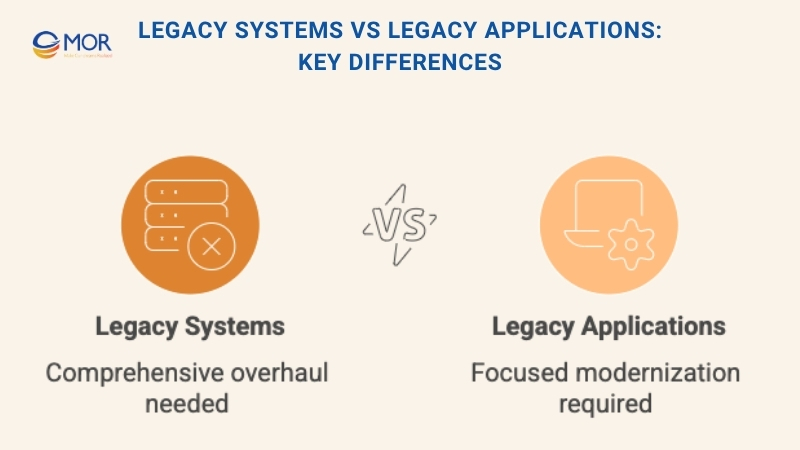
We’ve broken down the key differences in the table below:
Legacy System | Legacy Application | |
Definition | A full setup of outdated hardware, software, infrastructure, and workflows | A specific outdated software or program still in use |
Scope | Broad, includes servers, databases, interfaces, OS, and apps | Narrow, just the app, often tied to one platform or legacy operating system |
Examples | COBOL-based tax systems, on-premise ERPs, Windows Server 2003 stacks | Old payroll apps, internal portals, or order-entry tools |
Tied to OS/Hardware? | Often depends on outdated or unsupported machines | Usually designed for one OS version (e.g., Windows 7) |
Maintenance Needs | High, requires specialized skills, like COBOL or mainframe support | Medium to high, depends on integration and update frequency |
Risks | Broader: includes security, compliance, scalability, and performance issues | App-specific: bugs, browser conflicts, or loss of support |
Strategy to Fix | Often phased retirement or full system migration | Can sometimes be rewritten or modernized independently |
Whether you’re dealing with a large-scale legacy in IT infrastructure or just one outdated app, recognizing what you're up against is the first step. Make the wrong assumption, and you could waste months chasing the wrong fix.
What Are the Main Types of Legacy Systems?
There’s no single mold for legacy systems. They show up in different forms, but most fall into one of four types:
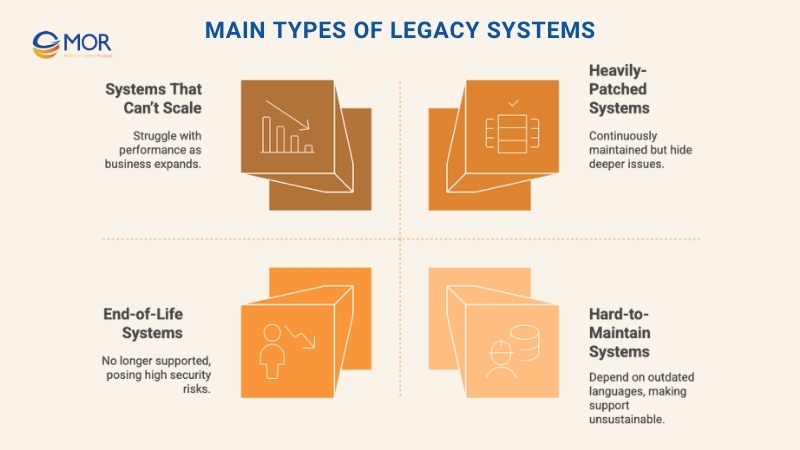
1. End-of-Life Systems
These are systems that vendors have stopped supporting. No more updates. No security patches. And no way to buy new licenses or parts. They're still running, but they're running solo. If you’re researching what is a legacy irp systems, especially in manufacturing or finance, you’ll often find old ERP setups in this category.
2. Systems That Can’t Scale
Some legacy systems were never built to handle modern data loads, security standards, or user growth. As your business grows, these systems hit a wall. They slow things down and create bottlenecks that get worse over time.
3. Heavily-Patched Systems
These are systems that have been kept alive with patches, lots of them. Each fix adds more complexity, and over time, those quick fixes turn into security risks. In some cases, patching only masks deeper problems that make the system unstable or unsafe.
4. Hard-to-Maintain Systems
Maintaining these systems means finding people who still know old coding languages or obscure platforms. That talent is rare. If your business depends on a system that needs COBOL or Visual Basic 6.0, it’s going to cost time and money just to keep things running.
Each type comes with its own risks. But they all point back to the same question: what is a legacy system, and how long can yours stay in place before it slows growth or exposes you to real problems?
Who Still Relies on Legacy Systems?
Despite the risks, legacy systems still run behind the scenes in some of the world’s most essential industries. Government offices, banks, insurance firms, and retail giants continue to depend on aging tech stacks to power core operations.
Across U.S. federal agencies, about 80% of the government’s annual USD 100 billion IT spend still goes to operating and maintaining existing, often decades-old, environments.
Take the U.S. government, for example. The Government Accountability Office reported that several agencies still run critical operations on outdated platforms. In 2017, a legacy computer system crash at the IRS halted electronic tax processing for nearly five million people. One glitch froze everything.
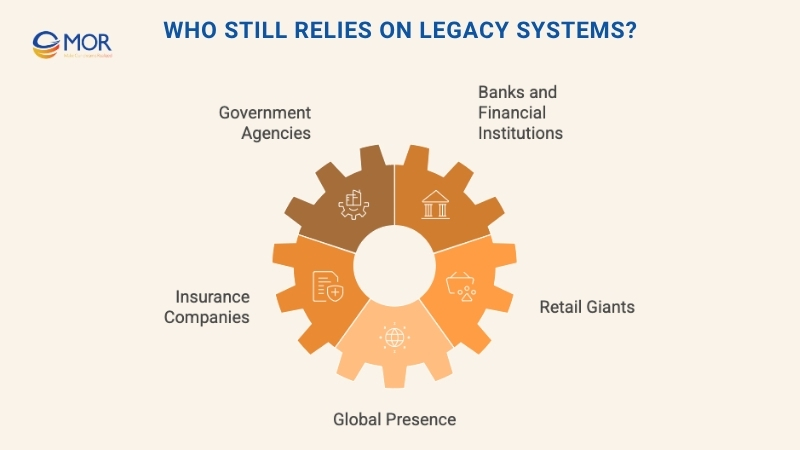
Another case? State-run unemployment systems. Many of them still use COBOL-based infrastructure developed more than four decades ago. During the COVID crisis, these systems couldn’t keep up, delaying benefits for over 13% of the jobless population. With so few engineers trained in COBOL today, repairs moved at a crawl.
In the banking world, more than 43% of core platforms still rely on COBOL code, underscoring just how entrenched these systems remain.
It’s not just a U.S. issue. Banks worldwide still use legacy in IT for everything from transaction processing to risk management. Retail chains rely on older inventory or point-of-sale systems because switching feels too risky or expensive in the short term.
The tools may be outdated, but they’re deeply embedded. And that makes change tough, until failure forces action.
Why Do Businesses Still Use Legacy Systems?
It’s easy to say, “Just upgrade.” But companies stick with legacy systems for some very real reasons.
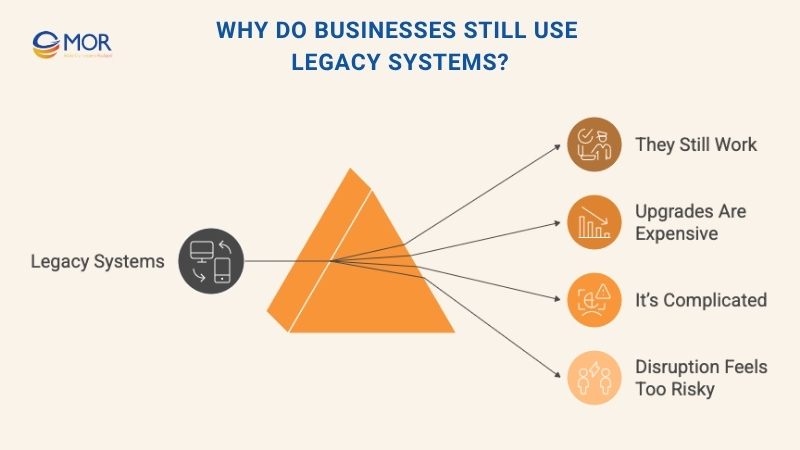
They Still Work
If a system runs day-to-day operations without breaking, most teams won’t rush to change it. These systems may be outdated, but they’re reliable, at least on the surface. For many, replacing something that still works feels like fixing a car that isn’t broken.
Upgrades Are Expensive
Swapping out a legacy system can cost a lot upfront. It’s not just the software or hardware. You’re also looking at data migration, staff training, downtime, and maybe even hiring people with new skills. That price tag can be a non-starter for smaller teams or budget-tight departments.
It’s Complicated
Legacy tech is usually tangled into everything else. Untangling it means facing risks: data loss, broken workflows, or customer-facing bugs. For many companies, the path to modern infrastructure feels like walking a tightrope without a net.
That’s why even now, many are still asking what is a legacy phone system, because they’re still using one. The tech’s outdated, but pulling it out would disrupt communication, training, and customer service all at once.
So instead of jumping straight to modern tools, some businesses choose to wait. Not because they want to, but because they feel like they have to.
What Are the Main Problems of Using Legacy Systems?
It’s not just about slow computers or clunky software. Legacy systems come with deeper problems that build up over time. Let’s break down the seven biggest risks companies face when they hold onto outdated tech.
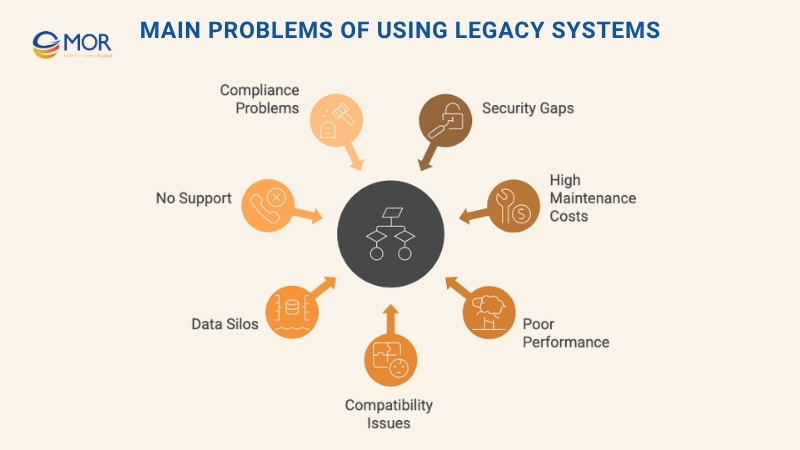
1. Security Gaps
Old systems miss modern defenses. They often lack basics like encryption, access control, and real-time monitoring. Hackers know this. That’s why legacy systems are frequent targets for malware and ransomware. They simply can’t keep up with current threats.
IBM’s 2024 Cost of a Data Breach Report pegs the average breach at USD 4.88 million, a record high that highlights how quickly outdated defenses translate into real losses.
And without vendor updates or security patches, every delay makes your data more vulnerable. This is one reason teams still ask what is a legacy system, because it often shows up as the weakest point in their IT stack.
2. High Maintenance Costs
Keeping old tech alive gets expensive, fast. Repairs aren’t just frequent, they’re inefficient. You might spend more patching a legacy application than rebuilding it from scratch. Plus, since few experts still support outdated tools, external help doesn’t come cheap.
3. Poor Performance
If your team constantly complains that systems are “slow,” you’re not alone. Legacy technology often lags behind in speed, UX, and functionality. Load times increase, crashes happen more often, and employee frustration grows. Productivity tanks because no one wants to wait 20 seconds for a simple task to load.
A 2024 Siemens study found that unplanned downtime now erodes 11% of revenue for Fortune Global 500 companies, about USD 1.4 trillion lost each year, and other research puts the per-minute impact as high as USD 9,000.
4. Compatibility Issues
Modern tools don’t mesh with old systems. That leads to workarounds, duplicate entries, and integration nightmares. Let’s say your CRM is cloud-based, but your accounting software is from 2003.
Good luck syncing those. When systems can’t talk to each other, users do it manually, wasting time and inviting errors. This is a common scenario when people wonder what is a legacy system extension and why things break when it’s used.
5. Data Silos
Outdated platforms often trap data in one place. You end up with multiple systems that don’t share information. This means teams across sales, ops, and finance are all working with different numbers. It slows down decisions, creates friction, and blocks the kind of big-picture visibility modern businesses need.
6. No Support
Once a vendor stops servicing a system, you’re on your own. Sure, a third-party firm might help in the short term. But as the system ages, that support dries up too. If something breaks, there’s no hotline to call. That’s a huge risk, especially in industries where uptime is everything.
7. Compliance Problems
Old systems weren’t built for today’s privacy and data laws. From GDPR to HIPAA, compliance rules have changed fast. Legacy tools can’t always track user consent, secure sensitive data, or log access history. If auditors come knocking, a legacy system could turn into a legal headache.
These seven issues explain why businesses need to rethink how they manage their tech stacks. Whether it’s a back-office tool or a customer-facing app, if you’re still asking what is a legacy system, you might be overdue for change.
How to Overcome Legacy System Challenges?
Outdated systems don’t have to stall progress. While legacy systems are deeply rooted in many operations, they’re not impossible to modernize. You just need the right strategy.
Here are four practical ways to tackle aging tech without flipping the entire stack overnight.
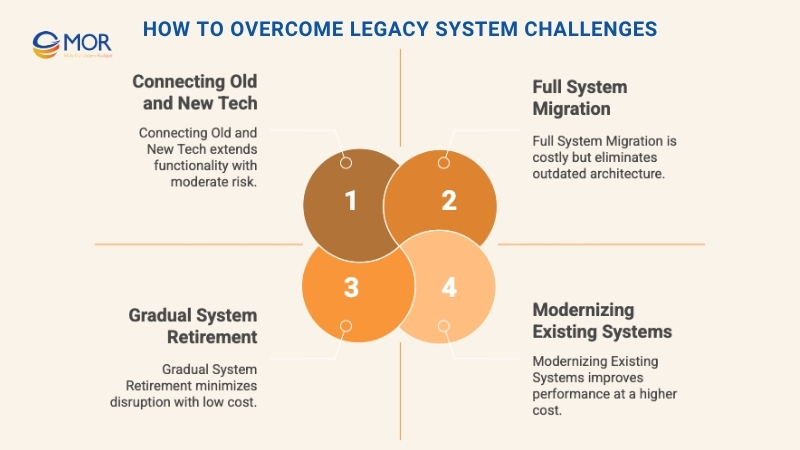
Modernizing Existing Systems
Think of this as a home renovation. You keep the core structure, but rebuild the weak points using new tools and frameworks. A modernized legacy system might run better, scale easier, and handle newer integrations, all without losing the workflows your teams rely on.
Why it works
- Keeps familiar processes intact
- Avoids full rebuilds or data loss
- Adds flexibility and performance boosts
But it’s not perfect
- Can get expensive
- Doesn’t fix deeper flaws in the original design
This approach works best when you want to keep key functions but bring them up to speed with current tech. Teams often follow this path when updating legacy applications tied to custom internal systems.
Full System Migration
Migration is a clean slate. You move everything, from workflows to data, to a new platform. This option is usually necessary when the old system is too rigid or unsafe to maintain.
Here’s how the migration process plays out:
- Data Transfer: Move data without corrupting or losing it
- Dual Systems: Run both old and new systems during rollout
- Training: Prep your team to use the new system fast
This path is ideal when you’re done patching and need a platform that supports real growth. If you’ve been wondering what is a legacy system and whether yours can survive another year, this may be your cue to migrate.
Connecting Old and New Tech
Not ready to let go? Integration helps bridge the gap. You can keep your legacy technology running while adding newer tools around it.
- Middleware: Translates data between old and new systems
- Custom APIs: Lets both platforms exchange info directly
This is a solid choice when the legacy system still does something valuable, but you want to modernize other parts of your stack. Think of this like using a smart thermostat in a house with an older heating system.
Gradual System Retirement
Sometimes ripping out old tech is just too risky. A phased approach lets you retire your legacy system in steps.
Here’s how that looks:
- Slowly shift features to new tools
- Keep core operations live during the transition
- Follow a timeline and roadmap to avoid chaos
This is a popular route for teams stuck using a legacy phone system or on-prem tools that need to move to cloud infrastructure. Instead of switching everything in one night, you pace the change for smoother results.
Whichever route you choose, the point isn’t just to upgrade, it’s to make your system work for the business, not against it.
How MOR Software Helps You Move Beyond Legacy Systems
Legacy systems are more than just old tech. They drain budgets, slow teams down, and open doors to security risks. We’ve seen these problems firsthand across industries, from banking to retail to logistics. That’s why we don’t just patch the problem. We help you replace it with something better.
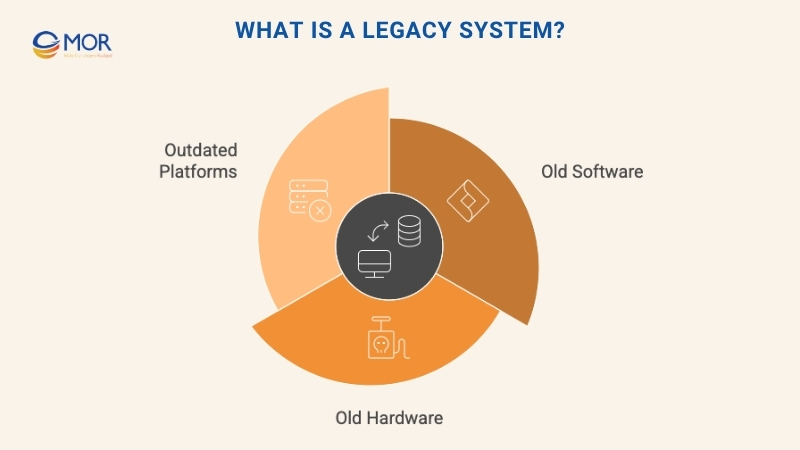
Here’s how we support your transition:
- Custom modernization plans: Whether you need a full system rebuild or smart integrations with existing platforms, we tailor our solutions to your tech stack and business goals.
- Full-cycle migration support: We don’t just move your data. We ensure your operations keep running while we do it. Our teams handle everything from backend migration to frontend compatibility.
- Cloud-ready development: Our engineers help you replace outdated systems with scalable, secure, cloud-native solutions that match today’s performance and compliance standards.
- Dedicated teams with legacy expertise: You don’t need to hunt for rare skills. Our dedicated teams include senior engineers experienced in legacy code (including COBOL, VB, .NET, and more) and modern stacks alike.
- Reduced risk, faster results: We break modernization into manageable phases, so you get wins early without interrupting business. Zero downtime isn’t just possible. It’s what we aim for.
If your system is holding you back, we’ll help you move forward securely, smoothly, and without starting from scratch.
Conclusion
Now that you understand what is a legacy system, the question becomes: what are you doing about yours? Legacy tools were built for a different era. They served their purpose. At MOR Software, we help businesses replace the outdated with the future-ready. Whether it’s full system migration, middleware integration, or modernizing what still works, we’ll get you unstuck. Let’s move your tech forward, together. Contact us to find out how.
MOR SOFTWARE
Frequently Asked Questions (FAQs)
Why do some companies keep legacy systems?
Because they still work. Many legacy systems are tightly woven into daily operations. Replacing them means spending time, money, and resources that some teams just don’t have right now. If the system still runs, they choose to keep it going, at least for the short term.
What’s the downside of technical debt from legacy systems?
Technical debt piles up fast with old systems. You spend more patching things, fixing bugs, and working around outdated tools. It slows down innovation and makes it harder to launch new features or products. That debt can also grow into real risks, like security breaches or compliance issues.
Can legacy systems still be useful?
Yes, to a point. If they’re stable and meet current needs, a legacy system can still bring value. But that value drops over time, especially when integration, speed, or support start breaking down. In some cases, businesses use a legacy system extension or middleware to squeeze more life out of their setup, but it’s always a temporary fix.
Rate this article
0
over 5.0 based on 0 reviews
Your rating on this news:
Name
*Email
*Write your comment
*Send your comment
1